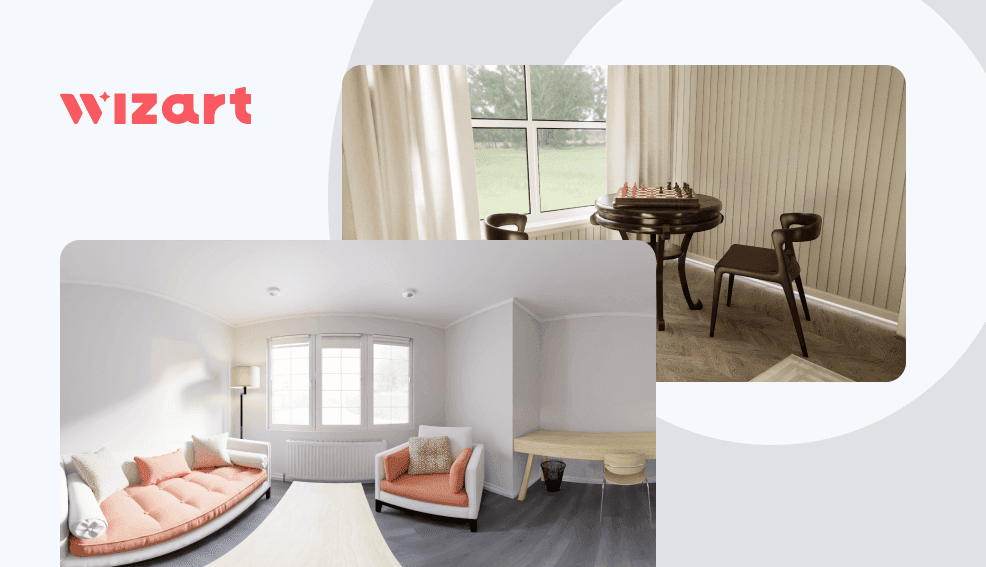How to Use VR and 3D Visualizals for Shopping in 2025

The force of virtual reality (VR) is growing every year. We are used to thinking that VR is only about headsets and video games. But in fact, VR has great potential in marketing as well. The statistic shows that implementing VR in your online store can increase your conversion by 17%.
So today, we’ll dive into this topic and discuss how to use VR for marketing and home design purposes.
What is VR?
Virtual reality is a computer technology that is used to create a simulation of a 3D world. VR can influence all five human senses and let the user interact and impact new imaginary worlds.
The main difference between augmented and virtual reality is that VR creates a whole new synthetic environment and places a user in it via computer graphics, AI sensors, and head and body trackers. And AR adds digital objects to the real world and allows you to interact with them.
What types of VR exist?
When talking about VR, we often imagine a person in a headset with controllers in their hands. However, there are 3 different types of VR, and not all of them require users to get expensive hardware.
The 3 main VR types are:
- Non-immersive virtual reality. We use this type of VR quite often in our daily lives without even realizing it. Non-immersive VR technology doesn’t need special equipment but a computer that will create a virtual environment. Video games or behind-the-wheel driving simulations are the easiest examples of non-immersive VR.
- Semi-immersive virtual reality. This type of VR provides an experience partially based on virtual components overlayed over real-world objects. Semi-immersive VR is often used for training and educational purposes. For example, flight simulators for pilots and aircraft crews use heads-over-the-display (HUD) technology to display virtual content on flight windshields for engine or fuel checks.
- Fully immersive virtual reality. This type of VR provides the user with a full 360 simulation and requires a full set of hardware like smart glasses, gloves, treadmills, and sense detectors for the creation of a realistic experience. Fully immersive VR is commonly used in gaming because it allows the creation of a virtual environment that is safe but hardly distinguished from reality.
How you can use VR in the marketing
90% of all information transmitted to the brain is visual, and it’s processed 60,000 times faster than text. This makes high-quality visualizations superior in any marketing campaign.
VR exceeds even the highest-resolution product photography and helps marketers to connect with buyers on a deeper level building a bridge between experience and action.
VR rooms and 3D product visualizations are the most common among marketers. Using this type of content, potential customers can see the product from all angles, get a closer look at the complicated textures, and interact with it.
Here are 3 examples of how VR and 3D visuals are used in retail companies to improve the virtual shopping experience:
#1. Virtual stores. In 2016, eBay partnered with Myer to create “the world’s first Virtual Reality (VR) Department Store.” Such VR stores aimed to serve as VR showrooms and let users browse through products the same way they would do it in a brick-and-mortar shop.
#2. Try-before-you-buy. This is probably the most common use of this technology, especially in combination with AR. Virtual fitting rooms allow users to try on clothes, shoes, makeup, and even furniture. IKEA has developed a virtual reality showroom - The Place App, which allows users to place furniture in their house using a smartphone camera, so they can check if it fits and how it will look in their interior.
#3. Interactive education. If you are working with a complicated product that is hard to explain or show how it works, you can use VR to teach your customers. For example, Lowe’s developed a VR application that guides users on how to use their Holoroom technology.
Benefits of VR technology for your business
VR has unlimited possibilities and endless commercial use cases, but they all share the same benefits:
- Better customer engagement. VR and 3D product visuals have higher engagement rates compared to ordinary content. Customers are curious about new possibilities, new technologies, and new experiences. This leads to the fact that they remember your brand better.
- Lower return rate. VR creates an experience of interacting with the product close to real life. As a result, customers have a better understanding of product features and don’t need to return not suitable items.
- Higher and faster conversions. Again, the better your customer understands your products, the easier and faster they will be ready to place an order.
- Lower costs. VR can help you save resources by replacing physical product samples and cutting costs on return deliveries and training procedures.
Where to start?
Let’s say you are interested in trying new types of content for your business. Do you need to hire a team of developers that can create your virtual showroom or marketing agency that works with 3D visualizations?
Luckily, we can save you from all this hustle. At Wizart, we offer a set of digital tools that help companies that work in the finishing materials market upgrade their product pages with new content, including virtual reality to visualize home renovation. We can help you with:
- Create VR rooms that allow users to see your products in the interior. Walk through the room, see it from different angles, and turn on and off lights. Check out the example of the Wizart VR room.
- 3D product visuals of objects and rooms can replace photos and get customers a better idea of product texture.
- And much more!
Contact us to find out how Wizart can help you grow your business with the latest technologies.

